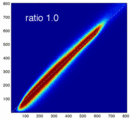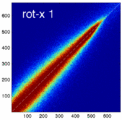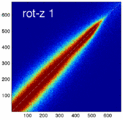Difference between revisions of "2011 Winter Project Week:RegistrationAnisotropy"
| Line 1: | Line 1: | ||
__NOTOC__ | __NOTOC__ | ||
| − | < | + | <gallery widths="300px" perrow="3"> |
| − | + | Image:RegEval_JointHist_AGif.gif|Fig.4: Example joint histogram blurring effects from anisotropic voxel size : 1x to 20x anisotropy | |
| − | + | Image:RegEval_JHBlur_RotX_AGif.gif|Fig.5: for comparison: example joint histogram blurring effects from rotation around x (LR) axis 1-15 degrees | |
| − | - | + | Image:RegEval_JHBlur_RotZ_AGif.gif|Fig.7: for comparison: example joint histogram blurring effects from rotation around z (IS) axis 1-15 degrees |
| − | + | ||
| − | + | </gallery> | |
| − | + | ||
=The 3DSlicer Registration Case Library Project= | =The 3DSlicer Registration Case Library Project= | ||
| Line 19: | Line 19: | ||
For this work we seek insight into the effects of voxel anisotropy and image inhomogeneity on registration accuracy and robustness. | For this work we seek insight into the effects of voxel anisotropy and image inhomogeneity on registration accuracy and robustness. | ||
| − | |||
| − | |||
</div> | </div> | ||
Revision as of 23:18, 13 January 2011
Home < 2011 Winter Project Week:RegistrationAnisotropy
The 3DSlicer Registration Case Library Project
Key Investigators
- BWH: Dominik Meier, Andriy Fedorov
Objective
For this work we seek insight into the effects of voxel anisotropy and image inhomogeneity on registration accuracy and robustness.
Approach, Plan
Aside from designing experiments for metrics that are specific to this effect, we also seek interaction with other projects that have highly anisotropic image data.
Example Experiment: produce directly joint histograms and difference(ratio) images w/o the need to run the actual registration, i.e. we compare the effects of voxel anisotropy on the theoretical optimum: Move, filter and subsample identical image pair, then resample back to original position and build joint histograms and subtraction images. Because of the increasing PV effects we expect to see a degenerating joint histogram and a subtraction image with increasing edge artifacts. We can then try to interpret how the optimizer will behave in this environment. The benefit of this metric is that we circumvent the stochastic nature of the registration output.
Progress
- see images above
- we identified prostate MRI as a promising dataset for testing. Since hi-res isotropic data is never avail., we will move from the current anisotropy (x7) toward isotropic. Also we have 2 orientations (coronal vs. sagittal) and can compare the effects of having the anisotropy run in a different direction.
- progress on exposing the ITK joint histogram functions and MI metric for quantifying the above shown effects.
Progress
project links go here


